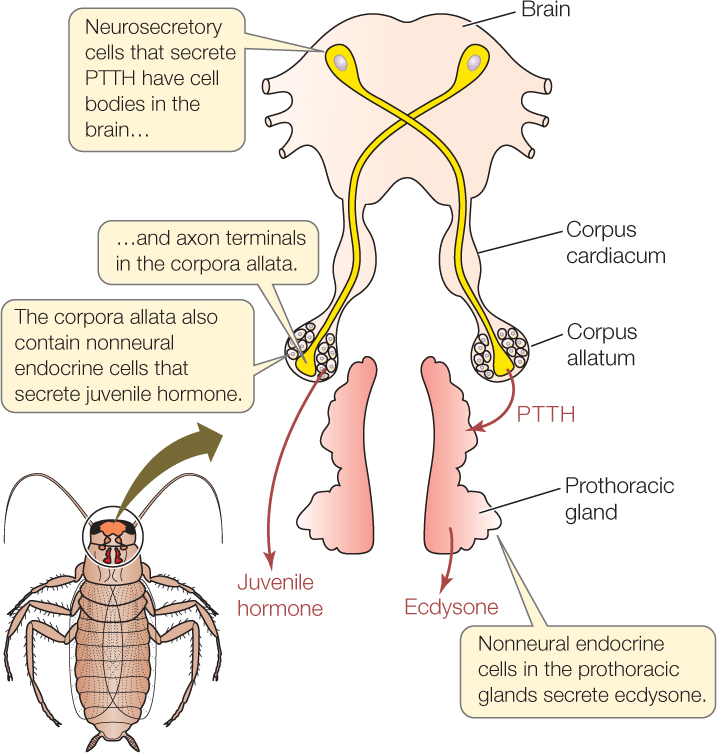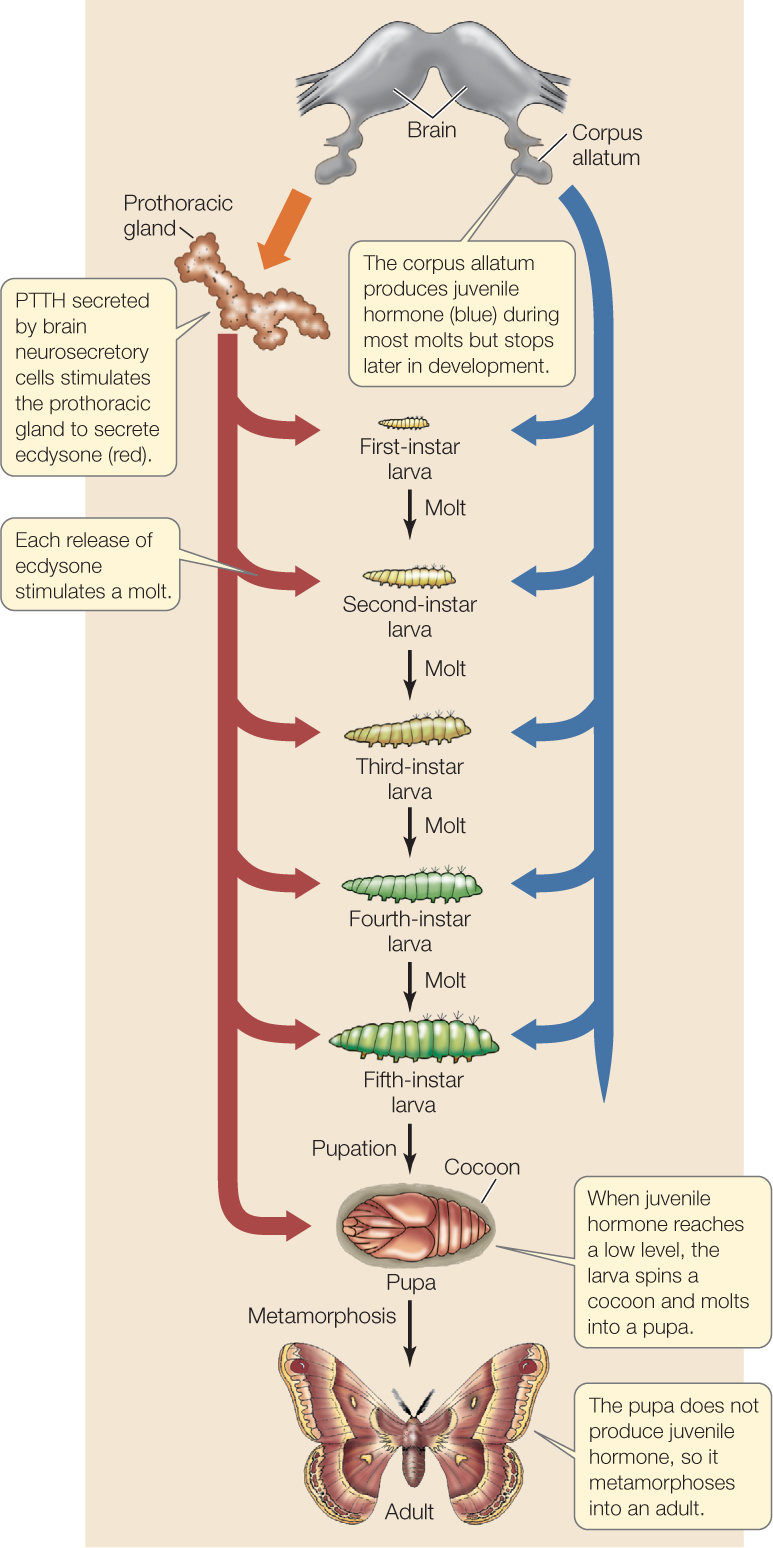Concept 35.5: The Insect Endocrine System Is Crucial for Development
Insects and other arthropods, such as crayfish and crabs, have elaborate endocrine systems. For example, many insects have antidiuretic and diuretic hormones that control excretion of water by the insect organs that serve kidney functions. Diuretic hormones promote excretion of a high volume of water. Some of the blood-sucking insects secrete diuretic hormones immediately after each blood meal. These hormones promote rapid excretion of much of the water in the blood, thereby concentrating the nutritious part of the meal (e.g., the blood proteins) in the gut.
The best-understood endocrine systems in insects control growth and development. A key feature of insects is that they have exoskeletons. For an insect to grow, it must periodically shed its exoskeleton and produce a larger one. This shedding process is called molting or ecdysis. The life of an insect consists of a series of discrete steps: growing followed by molting, then more growing followed by molting, and so on. Insects typically undergo changes in their external shape as they develop from young individuals to adults. However, the rigid exoskeleton cannot change shape between molts. This means that all the changes of external shape in the life of an insect must occur during molting. In this way, the molting process is intimately connected to both growth and morphological development (development of form).
Many hormones are involved in controlling the molting process, but three are of principal importance (FIGURE 35.14). We will start by discussing two of them and then address the third. One is prothoracicotropic hormone (PTTH), a peptide tropic hormone secreted by brain neurosecretory cells. The second is ecdysone, a steroid secreted by nonneural endocrine cells in the prothoracic glands. PTTH controls secretion of ecdysone. In the regulation of molting, neurosecretory cells in the brain control secretion of hormones into the general circulation by other endocrine cells. This is one of the two types of interface between the nervous and endocrine systems that we identified in vertebrates. Invertebrates and vertebrates, we see, sometimes exhibit similar major organizational features.

748
The brain uses its integrative and computational powers to determine when each molt will occur. The neurosecretory cells that secrete PTTH receive synaptic inputs from other, ordinary brain neurons that control when the neurosecretory cells will secrete their hormone. PTTH is not released directly from the brain, however. In an arrangement reminiscent of that in the posterior pituitary gland in vertebrates, axons of the brain neurosecretory cells extend out of the insect brain and end in or near organs called the corpora allata (singular, corpus allatum). These are neurohemal organs, where PTTH is released into the blood from the axon terminals of the brain neurosecretory cells.
During each episode of PTTH secretion, the flow of blood carries the PTTH to the two prothoracic glands, where it stimulates an episode of ecdysone secretion. As the ecdysone circulates, it undergoes peripheral activation to form 20-hydroxyecdysone, a hormone that primarily affects the insect’s epidermis, the layer of living tissue just inside the exoskeleton. The epidermis secretes the exoskeleton. The hormone, being a steroid, enters the epidermal cells. There it combines with intracellular receptors, which alter gene transcription patterns. As a result, the epidermal cells secrete enzymes that loosen their connection with the old exoskeleton, allowing the old exoskeleton to be shed. Then the epidermal cells synthesize a new, larger exoskeleton. In other words, a molt occurs.
Juvenile hormone (JH) is the third hormone of primary importance in the control of molting. It is secreted into the general circulation by nonneural endocrine cells in the corpora allata (see Figure 35.14). It is lipid-soluble and enters target cells (chemically it is a terpene and thus of a different sort than the other hormones we have discussed). Many types of cells in an insect’s body have intracellular receptors for JH and respond to it by undergoing changes in gene transcription. JH controls an insect’s body form as the insect molts. Some insects, such as moths and butterflies, undergo a complete metamorphosis during their development. Each individual starts life as a larva (caterpillar), retains its larval form for several molts, and then metamorphoses into an adult of radically different form (see Concept 23.4). Here we discuss the role of JH in such insects.
When a larva molts, it retains its larval form if JH is at high concentration in the blood during the molting process. During the early life of an individual, the blood concentration of JH is high. Molting thus results in a series of larger and larger larval forms (FIGURE 35.15). Later in life, however, JH secretion is reduced, and the JH concentration in the blood falls to a low level. At that point, when molting occurs, the juvenile form is not retained. Instead, the insect enters a resting stage of distinctive body form, called a pupa. During the inactive pupal stage, the insect’s body is extensively remodeled inside the pupal exoskeleton. Then, when the insect molts yet again without a high concentration of JH in the blood, the individual emerges as an adult.


Go to ANIMATED TUTORIAL 35.2 Complete Metamorphosis
PoL2e.com/at35.2
749
CHECKpoint CONCEPT 35.5
- Why is juvenile hormone called “juvenile” hormone?
- What two actions does ecdysone have on insect epithelial cells?
- In what way is there a fundamental similarity between (1) the control of ecdysone secretion by PTTH in insects and (2) the control of FSH secretion by GnRH in mammals?
Question 35.2
Why are the skeletal muscles under control of both the nervous system and the endocrine system?
ANSWER The muscles need to be controlled on two scales of spatial definition and two scales of time (Concept 35.1). The nervous and endocrine systems are suited to exerting control on these different scales—explaining why evolution has favored control by both systems. During a game of tennis, for example, the skeletal muscles of the arms, legs, and other parts of the body need to be controlled individually and on a moment-by-moment basis. Nervous control is suited to this task because it is addressed and fast. During adolescent development, muscles throughout the body need to be controlled together and on a sustained basis for many months as they grow and gain strength (Concept 35.4). Endocrine control is suited to this task because it is broadcast and slow.